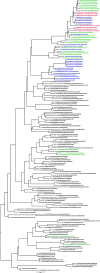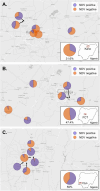Evaluating the impact of avian paramyxovirus type 1 infection in poultry at live bird markets in Nigeria: defining hurdles to sustainable agriculture
- PMID: 39939962
- PMCID: PMC11817539
- DOI: 10.1186/s12917-025-04508-2
Evaluating the impact of avian paramyxovirus type 1 infection in poultry at live bird markets in Nigeria: defining hurdles to sustainable agriculture
Abstract
Background: Infectious diseases including Newcastle disease (ND) impair poultry productivity and represent a significant burden to sustainable agriculture in Nigeria. This study aimed to investigate the active circulation and seroprevalence of Newcastle disease virus (NDV) caused by virulent forms of avian paramyxovirus type-1 (APMV-1) in poultry at live bird markets (LBMs) across Nigeria.
Methods: A cross-sectional study of 18 LBMs was conducted within three states in Nigeria (Kano, Oyo, and Abuja). Paired swab and tissue samples (n = 413) were collected from birds on FTA cards and tested for APMV-1 using real-time reverse transcription polymerase chain reaction (rRT-PCR). A subset of rRT-PCR-positive samples were selected for whole genome sequencing based on the originating species (chicken, duck, geese), date, and market location to provide a broad range of isolates for characterisation. Blood samples (n = 405) were also collected from birds and the seroprevalence of APMV-1 antibodies was measured using an enzyme-linked immunosorbent assay (ELISA).
Results: APMV-1 RNA was detected in 21.5% (89/413) of samples from LBMs by rRT-PCR. At least one APMV-1 positive sample was detected in 55.6% (10/18) of LBMs. The largest proportion of APMV-1-positive markets was in Kano (83.3%, 5/6), whereas the lowest was in Oyo (16.7%, 1/6). Assessment of genetic data demonstrated that genotype XIV.2 APMV-1 was circulating within Nigeria with the viruses detected clustering closely with other Nigerian isolates described previously. The seroprevalence of APMV-1 in birds was 45.9% (186/405) and 94.4% (17/18) of LBMs had at least one APMV-1 seropositive sample (i.e., with at least one APMV-1-antibody-positive bird). The LBMs in Kano had the lowest seroprevalence (88.3%, 5/6).
Conclusions: This study demonstrated that APMV-1 continues to circulate in LBMs in Nigeria. LBM traders, poultry producers, and related industry and policy stakeholders should be aware of the occurrence of APMV-1 and how ND may negatively impact upon poultry production and the livelihoods of poultry farmers and LBM traders. Training initiatives aimed at improving the knowledge of APMV-1 infection and improvements in biosecurity practises and the role of disease mitigation through vaccination are required to reduce the impact of this threat to food security.
Keywords: Africa; Avian paramyxovirus; Live-bird markets; Newcastle disease; Nigeria; Poultry; Virulent.
© 2025. The Author(s).
Conflict of interest statement
Declarations. Ethics approval and consent to participate: Ethical approval was obtained from Ahmadu Bello University, Nigeria (Reference number: ABUCAUC/2019/009) and University of Surrey, United Kingdom (favourable ethical review by Animal Welfare and Ethical Review Body received on November 04, 2019). Permission to participate in the study and informed consent was obtained from each live bird marketer before sampling of birds at the market stalls and completion of a market stall questionnaire. All sample collection from poultry was carried out in accordance with relevant guidelines and regulations. Consent for publication: Not applicable. Competing interests: This study was supported by the Africa Livestock Productivity and Health Advancement (ALPHA) Initiative, co-funded by Zoetis and the Bill & Melinda Gates Foundation. Two of the co-authors (EM and GV) are employed by Zoetis. EM and GV were involved in the writing of the manuscript. There are no potential areas of bias which may confer any advantage to Zoetis. All other authors do not have any kind of competing interests.
Figures




References
-
- Adene DF OA. The Structure and Importance of the Commercial and Village Based Poultry Industry in Nigeria. Rome: FAO; 2006. Available at: https://www.inter-reseaux.org/wp-content/uploads/pdf_poultrysector_nga_e...
-
- Adene DF OA. Poultry sector country review. Rome: FAO; 2008. Available at: https://www.readkong.com/page/poultry-sector-country-review-fao-animal-p...
-
- Organisation FaA. The Future of Livestock in Nigeria. Opportunities and Challenges in the Face of Uncertainty. FAO Rome, Italy; 2019. Available at: https://www.fao.org/3/ca5464en/ca5464en.pdf
-
- Sonaiya E. Family poultry, food security and the impact of HPAI. Worlds Poultry Science Journal. 2007;63(1):132–8. 10.1017/S0043933907001353.
-
- Ameji NO, Oladele OO, Jambalang AR, Adanu AW, Chinyere CN, Meseko CA, et al. Multiple Outbreaks and Clinico-pathological Features of Highly Pathogenic Avian Influenza H5N1 and H5N8 in Poultry Farms in Jos Metropolis, Plateau State. Nigeria Journal of World’s Poultry Research. 2021;11(3):376–86. 10.36380/jwpr.2021.45.
MeSH terms
Substances
LinkOut - more resources
Full Text Sources

